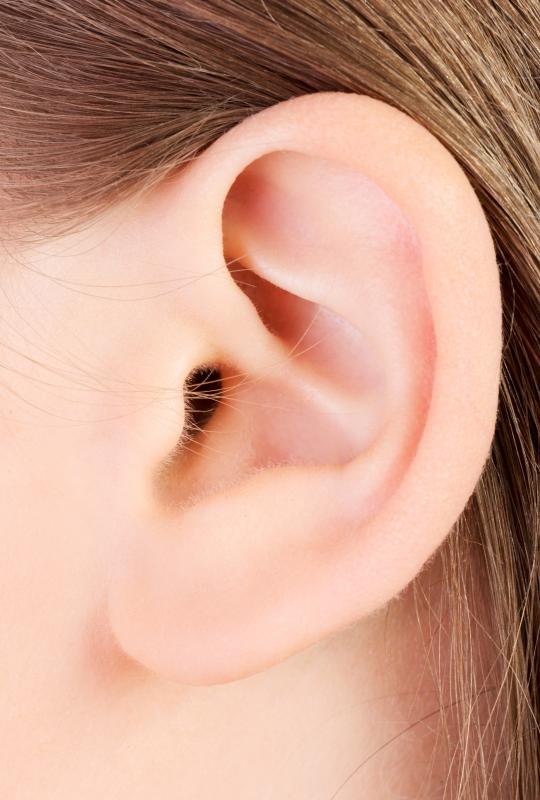At TheHealthBoard, we're committed to delivering accurate, trustworthy information. Our expert-authored content is rigorously fact-checked and sourced from credible authorities. Discover how we uphold the highest standards in providing you with reliable knowledge.
What is Ear Cartilage?
The structure and shape of the outer ear is not derived from internal bone structure but from ear cartilage. This makes the ear a cartilaginous structure as it is given its shape by the cartilage. Elastic or yellow cartilage found in the outer ear is also found in the larynx and epiglottis. This cartilage contains elastic fiber networks and collagen fibers. It is surrounded by the perichondrium, which supplies nutrients to the cartilage.
An injury that separates the perichondrium from the ear cartilage is known as cauliflower ear. Wrestlers, fighters and rugby players are most susceptible to this type of injury. A blow to the ear can allow a blood clot or other fluid to collect between the cartilage and the perichondrium, depriving the cartilage of necessary nutrients. If the cartilage dies, fibrous tissue forms in the overlying skin. This leaves the outer ear looking lumpy and deformed, resembling a cauliflower.

Cartilage does not heal easily or quickly as there is no blood flow within the cartilage. In the case of trauma to the external ear, any fluid needs to be drained to promote healing and allow the perichondrium to nourish the underlying cartilage. In addition to draining the fluid, silicone splints are sometimes applied to both sides of the ear to apply pressure. This pressure keeps fluid from recurring and speeds the healing process. Headgear worn in wrestling, boxing, and rugby is designed to minimize potential ear trauma.

If the ear cartilage is pierced, the healing time can be up to a year. The cartilage piercing instrument traumatizes a localized area of cartilage. Cartilage tissue can become infected and swelling can occur in the area of the piercing. The best defense against infection is proper handling of the area after a cartilage piercing. Keeping the area clean and not touching it are critical for proper healing as cartilage piercings have a much higher infection rate than ear lobe piercings.

In the event that a cartilage piercing displays signs of infection, such as redness, swelling, or oozing, it is important to visit a doctor. The piercing may need to be removed and antibiotics may be necessary to deal with the infection. Even with successful antibiotic treatment, a portion of the cartilage may die. This may result it cauliflower patches on the outer ear.

Not only does cartilage provide structure to the outer ear, it helps keep the shape that captures maximum sound waves. Damage to the cartilage can result in decreased normal hearing. If the shape of the outer ear is compromised, hearing aids will not work as effectively if or when needed. Ear cartilage is a flexible and vital part of a healthy, functioning ear.
AS FEATURED ON:
AS FEATURED ON:















Discussion Comments
@Mor - I hope you got it pierced properly with a needle, rather than a gun. A piercing gun shouldn't really be used for anything, but you can get away with it in the lobes. A decent piercing artist will always use a needle to get it done properly in any other place.
And cartilage is very easy to damage. If you have a look at the pictures of people with cauliflower ears you will very quickly develop an urgent need to protect your own ears from harm.
@KoiwiGal - I find it's difficult to get that kind of earring because they are all shaped to wrap around the ear and an ear cartilage cuff never seems to fit me. My ear must be too big or the piercing isn't quite in the right place or something like that.
I generally just leave a high quality earring in place there and forget about it, though, as they are so hard to put in and take out compared with lobe earrings.
I was always afraid to get a cartilage piercing, even though I liked the look of them, because I had the idea in my mind that cartilage was easily damaged and that piercing it might cause it to split open.
I think I thought this because my only experience with cartilage was the stuff you find on certain chicken bones and it seemed very fragile.
Of course, it's fragile because it's probably a different kind of cartilage and it's also been cooked by the time I see it. Eventually my friend managed to convince me to get the piercing I wanted and I've never had any problems with it. Although ear cartilage jewelry can be difficult to find sometimes.
Post your comments